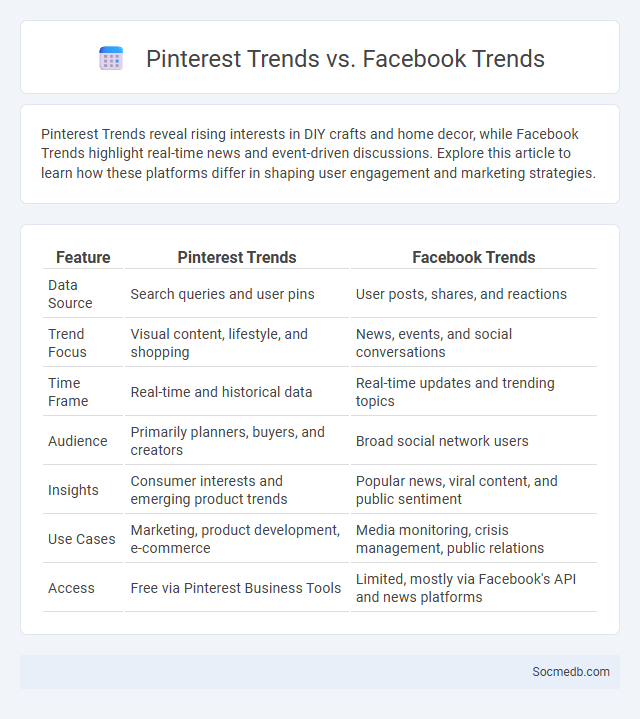
Photo illustration: Pinterest Trends vs Facebook Trends
Pinterest Trends reveal rising interests in DIY crafts and home decor, while Facebook Trends highlight real-time news and event-driven discussions. Explore this article to learn how these platforms differ in shaping user engagement and marketing strategies.
Table of Comparison
| Feature | Pinterest Trends | Facebook Trends |
|---|---|---|
| Data Source | Search queries and user pins | User posts, shares, and reactions |
| Trend Focus | Visual content, lifestyle, and shopping | News, events, and social conversations |
| Time Frame | Real-time and historical data | Real-time updates and trending topics |
| Audience | Primarily planners, buyers, and creators | Broad social network users |
| Insights | Consumer interests and emerging product trends | Popular news, viral content, and public sentiment |
| Use Cases | Marketing, product development, e-commerce | Media monitoring, crisis management, public relations |
| Access | Free via Pinterest Business Tools | Limited, mostly via Facebook's API and news platforms |
Introduction to Social Media Trend Analysis
Social media trend analysis involves examining current patterns, hashtags, and user interactions across platforms like Instagram, Twitter, and TikTok to identify emerging topics and consumer interests. By leveraging tools such as sentiment analysis and engagement metrics, you can gauge public opinion and predict shifts in audience behavior, optimizing your content strategy accordingly. Understanding these trends helps your brand stay relevant and connect effectively with target demographics in a fast-evolving digital landscape.
Understanding Pinterest Trends: Visual Discovery Engine
Pinterest Trends offers valuable insights into emerging visual content patterns by analyzing user interactions and popular search queries across the platform. Leveraging these trends allows you to tailor your social media strategy to capitalize on what audiences are currently interested in, enhancing engagement and visibility. This visual discovery engine prioritizes seasonal and niche-specific topics, providing data-driven opportunities for content optimization and brand growth.
Decoding Facebook Trends: Social Sharing Impact
Decoding Facebook trends reveals the profound impact of social sharing on content visibility and user engagement, as the platform's algorithm prioritizes posts that spark interactions. Your ability to leverage trending topics and encourage shares can significantly enhance organic reach and brand awareness. Insights into share patterns and audience preferences enable tailored strategies that maximize influence and drive meaningful conversations.
Global Digital Trends: Beyond Specific Platforms
Global digital trends highlight the rapid growth of mobile internet usage, the rise of short-form video content, and increasing adoption of augmented reality features across various social media platforms. AI-driven personalization enhances user experience by tailoring content to individual preferences, boosting engagement rates worldwide. Your brand can leverage these broader digital behaviors to optimize reach and relevance beyond any single social media app.
Content Virality: Pinterest vs. Facebook
Content virality on Pinterest thrives due to its image-centric platform and algorithm favoring visually appealing pins that encourage sharing and repinning within niche communities. Facebook's virality depends heavily on user engagement through comments, likes, and shares within a diverse network, boosted by algorithmic promotion of trending content and personal connections. Pinterest typically sees longer content lifespan and organic discovery, whereas Facebook's viral content often experiences rapid spikes followed by quicker declines.
Audience Demographics: Who Drives Trends?
Millennials and Gen Z dominate social media platforms, driving trends with their high engagement rates and content creation. Platforms like TikTok and Instagram have become epicenters for youth culture, with users aged 16-34 contributing to viral challenges and influencer marketing. Understanding these demographics enables brands to tailor campaigns that resonate with the primary trendsetters online.
Trend Lifespan: Platform-Specific Timelines
Trend lifespan varies significantly across social media platforms, with TikTok trends often peaking within days, while Instagram trends may persist for weeks. Your engagement strategies should consider these platform-specific timelines to maximize content relevance and audience interaction. Understanding the rapid evolution of trends on Twitter versus the more sustained visibility on Facebook enables better targeting and timely content creation.
Business Impacts: Leveraging Trends for Marketing
Businesses can leverage social media trends to enhance brand visibility, engage target audiences, and drive sales through timely, relevant content tailored to platform-specific algorithms. Utilizing data analytics and influencer partnerships maximizes campaign effectiveness by aligning marketing strategies with consumer behavior insights. Social media's dynamic nature enables agile adaptation to emerging trends, fostering competitive advantage and sustained business growth.
Tools and Metrics for Tracking Social Trends
Social media tools like Hootsuite, Sprout Social, and Brandwatch enable precise tracking of social trends by analyzing engagement rates, hashtag performance, and audience sentiment across platforms. Metrics such as reach, impressions, share of voice, and sentiment score provide actionable insights into your audience's behavior and content effectiveness. Using these tools and metrics empowers you to optimize campaigns and stay ahead of emerging social media trends for enhanced brand visibility.
Future Predictions: Evolution of Online Trends
Social media is expected to evolve with increased integration of augmented reality (AR) and artificial intelligence (AI), creating immersive and personalized user experiences. Platforms will leverage AI-driven analytics to predict and shape viral trends, enabling your content to reach targeted audiences more effectively. Emerging technologies will also drive the adoption of decentralized social networks, enhancing data privacy and user control over digital identities.
 socmedb.com
socmedb.com